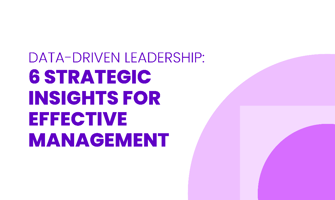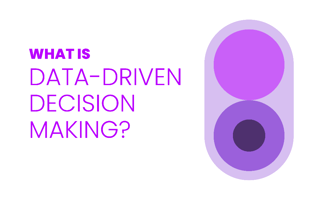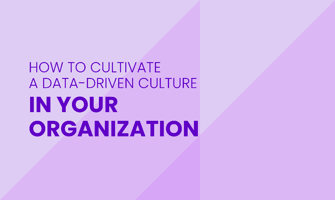Leaders in various industries are increasingly aware of the power of data for shaping decisions and...
Leveraging Data-Driven Decisions to Boost Customer Success - 5 Tips
Data is the backbone of any successful business strategy and customer success is no exception.
Leveraging data-driven decisions transforms not just the way businesses operate but also how they engage with their clients, leading to improved satisfaction and loyalty. In a world where understanding and meeting customer needs are paramount, adopting a data-driven culture becomes essential for business growth.
The goal of this article is to equip you with five actionable tips that will enable your organization to boost customer success using a strategic, data-driven approach. By integrating these practices into your operations, you're not just reacting to changes in customer behavior; you're anticipating them and acting proactively.
Tip1: Implement Comprehensive Data Collection for a holistic CS view
To truly understand and meet your customers' needs, collecting diverse types of customer-related data is crucial.
This approach ensures you gain a comprehensive view of customer behaviors and preferences, which is essential for enhancing customer success (CS). By gathering detailed insights across various touchpoints, businesses can tailor their services to better align with what their customers value most.
Key Data Types for CS
Several key types of data are instrumental in painting a full picture of the customer journey:
Transactional Data: This includes purchase history, product usage patterns, and subscription details. It helps you track how often and in what ways customers interact with your products or services.
Interaction Data: Details from emails, social media interactions, website visits, and other communication channels fall into this category. They reveal how customers engage with your brand.
Feedback: Direct input from surveys, complaints, NPS scores (Net Promoter Score), satisfaction ratings via tools like interviews or free-text feedback provides invaluable insights into how customers perceive your offerings.
Support Tickets: Analyzing issues reported by users gives clues about potential areas for improvement in both products/services and the overall user experience.
Each type contributes uniquely to understanding the nuances of each customer's experience with your business. Transactional data might show that certain features are popular among them. Interaction data could indicate common questions or concerns that arise during use.
Feedback directly voices user satisfaction levels whereas support tickets highlight specific problems encountered.
Integrating Data into a Single Source of Truth
Merging these varied sources into one unified platform simplifies access to critical information. A single source of truth enhances decision-making accuracy as it provides a holistic view without needing to cross-reference multiple systems or databases.
Methods include using advanced CX tech stacks that consolidate all forms of feedback—emails through social media mentions—and behavioral analytics from website interactions within one dashboard equipped with qualitative analysis capabilities.
The benefits extend beyond mere convenience; improved accessibility means quicker response times to emerging trends or issues identified through real-time monitoring tools embedded within these platforms.
Robust data governance is an important practice alongside integration efforts. Together they ensure integrity and security across diverse types of data. This safeguards against potential breaches and mishandling of sensitive information.
Tip2: Utilize Advanced Analytics Tools
Advanced analytics tools are at the forefront of transforming customer success strategies.
These platforms can sift through complex datasets to discover insights that were previously inaccessible. By leveraging these insights, businesses can adopt a proactive approach to customer success, ensuring they not only meet but exceed customer expectations.
The market offers a variety of analytics tools, each with unique features designed to tackle different aspects of data analysis. Some focus on predictive analytics, which allows companies to forecast future trends and behaviors based on historical data. Others specialize in customer segmentation, helping businesses tailor their services and communications to specific groups for more personalized engagement.
One significant advantage of using advanced analytics is the ability to identify customers who may be at risk of churning. This insight enables companies to intervene early, offering targeted support or incentives that could turn potential churners into loyal advocates. These tools can also help in spotting opportunities for up-selling or cross-selling by analyzing purchase patterns and preferences.
Emerging trends in this space include AI-driven analytics tools that push the boundaries of predictive capabilities even further. These next-generation solutions leverage machine learning algorithms to refine their forecasts over time continually, providing ever-more-accurate insights into customer behavior and needs.
For those looking to leverage data-driven decision-making, embracing advanced analytics is a necessity. Understanding your customers better than they understand themselves could be the key difference between thriving and surviving.
Tip3: Automate and streamline customer success processes
Automation plays a crucial role in optimizing customer success workflows.
By automating routine tasks, businesses can ensure that their interactions with customers are both timely and consistent. This not only improves efficiency but also allows customer success teams to focus on more strategic activities that require a personal touch.
Integrating Customer Relationship Management (CRM) systems with automation tools is key to triggering specific actions based on data insights.
For example, if the system identifies a decrease in product usage, it can automatically send out a check-in email or offer help through tutorial content. This proactive approach ensures that customers receive support exactly when they need it without any delay.
Several processes benefit significantly from automation:
Regular follow-ups ensure ongoing engagement and provide opportunities for feedback.
Sending out customer satisfaction surveys at critical points in the customer journey helps gather valuable insights into what's working well and what needs improvement.
Automated alerts for account managers about significant changes in account activity enable them to act swiftly to address potential issues.
Machine learning enhances these automated processes by predicting future customer needs based on past interactions. This advanced technology can identify patterns that humans might overlook, making predictions more accurate and actionable.
By streamlining these aspects of customer success through automation, businesses can maintain high levels of service while managing resources effectively. It's about being proactive rather than reactive—anticipating your customers' needs before they even have to ask.
Tip4: Use Data for Customer Education
Understanding your customers' needs and how they interact with your product is crucial.
This understanding can significantly enhance the effectiveness of customer education efforts. By analyzing data on customer usage patterns and feedback, you can pinpoint exactly where customers might be struggling or what features they're not fully utilizing.
One approach to leveraging this insight is by creating personalized educational content. For instance, if data shows that a significant portion of users frequently explore but rarely utilize a specific feature, this could indicate a gap in knowledge or understanding. Addressing this through targeted tutorials or guides can empower customers to make the most out of your product.
Moreover, educated customers tend to require less support, which directly translates into reduced support costs for your business. They are also more likely to use the product in more sophisticated ways, which can lead to better outcomes for them and increased loyalty towards your brand.
We believe in the power of adaptive learning platforms as well. These platforms adjust educational content in real-time based on how a customer interacts with it. If a user breezes through certain topics but spends more time on others, the platform will offer additional resources on those challenging areas automatically.
By investing in educating your customers using insights drawn from their own behavior and feedback you:
Improve their overall experience.
Reduce potential frustrations.
Encourage optimal use of your offerings.
Educated users are empowered users who feel valued by brands that invest time into ensuring they understand how best to use products or services offered—leading not just to improved usage but also building long-term relationships based on trust and value.
Tip5: Leverage Sentiment Analysis For Satisfaction Tracking
Sentiment analysis can be leveraged for understanding how customers feel about your service or product.
By examining the words and phrases used in customer feedback across various channels, such as reviews, social media posts, and support interactions, you can get a clear picture of their emotions and satisfaction levels. This approach allows businesses to spot potential issues early on and assess the overall health of their customer relationships.
One practical step towards implementing sentiment analysis is to start collecting feedback from all available communication channels. Then, using sentiment analysis tools or software that incorporate Natural Language Processing (NLP), you can analyze this data to identify common themes in how customers express their feelings about your brand.
Whether it's joy for a problem solved quickly or frustration over an unresolved issue, recognizing these sentiments helps tailor your customer success strategies more effectively.
Integrating sentiment analysis findings into your broader customer success strategy ensures that every decision made is informed by direct insights into how customers are feeling. This could mean adjusting communication tones in marketing materials based on predominant customer moods or identifying specific areas where the product needs improvement to enhance user satisfaction.
Combining sentiment analysis with NLP technologies offers an advanced way of deciphering not just overt expressions of happiness or dissatisfaction but also subtler cues that might indicate emerging trends in customer preferences or concerns before they become widespread issues.
By actively leveraging these techniques within your CS efforts, you're better equipped to foster stronger connections with your audience—leading not only to improved immediate resolutions but also building long-term loyalty through demonstrated understanding and responsiveness to their emotional states.
Conclusion
By integrating these practices into your operations, you position your business not just to respond to but also anticipate the needs of your customers. This proactive stance is key in building stronger relationships that foster satisfaction and loyalty.
We encourage you to adopt these data-driven strategies as part of your ongoing effort to drive business growth through exceptional customer success outcomes.
FAQ
How can organizations effectively use customer feedback to enhance customer success?
Organizations can effectively use customer feedback by actively analyzing it to identify common pain points, preferences, and satisfaction levels. This information should be integrated into product development and customer service strategies to directly address customer needs and enhance overall satisfaction.
How can surveys and interviews be optimized to gather more actionable insights for customer success?
Surveys and interviews can be optimized by designing questions that are open-ended and specific to understanding the customer's experience and expectations. Additionally, segmenting the audience and tailoring questions based on customer profiles or past interactions can yield more relevant and actionable insights.
What are the best practices for using emails and social media to enhance customer engagement and feedback collection?
Best practices for using emails and social media include personalizing communication to fit the recipient's history and preferences, using engaging content that prompts interaction, and providing clear, easy ways for customers to provide feedback directly through these channels.
What is the significance of free-text feedback in understanding customer needs?
Free-text feedback is significant as it allows customers to express their thoughts and feelings in their own words, providing richer, qualitative data that can reveal deeper insights into their experiences, expectations, and potential areas for improvement that structured data might miss.
Why is customer segmentation crucial in data-driven decision-making for enhancing customer success?
Customer segmentation is crucial because it allows organizations to tailor their strategies and communications based on distinct group characteristics. This targeted approach ensures that resources are used more efficiently and that interventions are more likely to resonate with the specific needs and preferences of each segment, thereby enhancing overall customer success.




